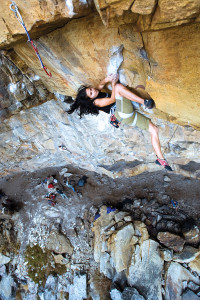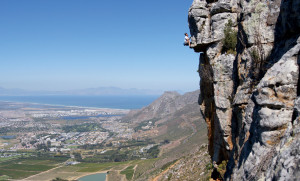Introduction
The Cape Peninsula is renowned for its world-famous landmark, one of the New 7 Wonders of Nature – Table Mountain and the Table Mountain chain. This rugged mountain chain creates an undulating ridge, which forms the backbone of the Peninsula, starting from the striking front of Table Mountain that overlooks the city, running through the beautiful and exposed Silvermine Reserve, over the cave-riddled Kalk Bay mountains and ending in the Cape of Good Hope Reserve at Cape Point – the very tip of the Peninsula.
Fortunately for climbers in Cape Town, the Cape Peninsula is blessed with a string of great crags giving very diverse climbing from short powerful routes on the bulging quartzite crags of Trappieskop and Peer’s Cave, the ever-popular faces of the Silvermine crags, to the very steep and mega-pumpy crags of The Mine and The Hole. As far as grades are concerned, there is something for everyone. Crags like Lakeside Pinnacle, Lower Silvermine and Higgovale Quarry are popular among beginners and for those who want a relaxing day at the crag, while Silvermine Main Crag and Fawlty Towers takes one up a notch or two. Whatever your desires, there are many routes on quality sandstone, just waiting to be caressed by your fingertips. Just go out and get ’em!
For a guide to all the trad climbing on the Cape Peninsula get Cape Peninsula Select – A guide to trad climbing in the Cape Peninsula.
Access
The entire Table Mountain chain falls under the jurisdiction of the Table Mountain National Park and a Wild Card will get you free entrance into Silvermine, as well as any other reserve on the Peninsula as well as throughout the Western Cape and the country, depending which cluster you purchase. For Cape Town residents who do not have a Wild Card, there is also the option of purchasing a My Green Card. This is an annual card, which allows the holder 12 free entries into any Cape Peninsula reserve, including Silvermine. Okay, so all this just gains you entry. To actually climb (sport climbing only), you will also need to purchase an Activity Permit. This permit is valid for one year and allows you to climb anywhere on the Cape Peninsula. But if you are a member of the MCSA, then you will not need an Activity Permit. Remember to carry your MCSA card. For further information or clarity on all this card stuff, contact Table Mountain National Park on +27 (0)21 712 7471 or tablemountain@sanparks.org. For all access updates and information, you can also call the Mountain Club of South Africa (MCSA) on +27 (0)21 465 3412.

Naureen Goheer cranking through the first crux on A Gift of Wings (28/7c), The Mine. Photo Micky Wiswedel
Weather and when to visit
The Cape Peninsula generally gets all the weather systems before the rest of the Western Cape, and often more severely than the inland areas. In saying that, the Peninsula is still a year-round climbing destination, but can be rather wet and miserable if you are unlucky enough to pick a rainy period for your holiday. To be safe, plan to visit during the long summer months. It may get hot, but there are always shady crags to climb on, and you will be able to enjoy the beaches, the awesome summer evenings, and take advantage of long daylight hours.

Prof. Steven Bradshaw pulling off some chemistry on his as yet unrepeated test piece, Hey Jupiter (34/8c), Underside, Cape Peninsula. Photo Guy Holwill
Accommodation
Although there are one or two campsites on the Peninsula, camping is not recommended. These campsites are far from the city, and it’s generally not safe to leave tents and camping stuff unattended while out climbing for the day. Depending on your financial position, there is a wide range of backpacker lodges, guest houses, B&Bs and hotels scattered throughout the Peninsula. Generally, the closer you are to the city and the Waterfront, the more you will pay for accommodation. A popular backpacker lodge among visiting climbers is Green Elephant in Observatory. Contact them on +27 21 448 6359 or greenelephant@iafrica.com. They are close to the City Rock indoor climbing gym and also to the trendy Lower Observatory Main Road, which has some good cafes, pubs and restaurants. Observatory is a short drive from the city centre and V&A Waterfront. For more information on accommodation elsewhere on the Peninsula, contact the Western Cape Tourism office on +27 21 426 5647 or info@cape-town.org.




